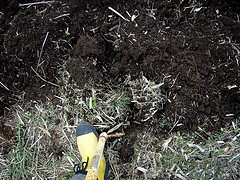Natural Fixes for Poor Garden Soil
 If your garden plants are flopping instead of flourishing, the problem could well be your soil. Many enthusiastic amateur gardeners believe that any soil problems can be fixed by adding organic matter, but in fact this is not always the case. It’s important to first identify the specific nature of the problem before taking action to remedy it. Patience is also essential, because restoring poor soil to health takes time.
If your garden plants are flopping instead of flourishing, the problem could well be your soil. Many enthusiastic amateur gardeners believe that any soil problems can be fixed by adding organic matter, but in fact this is not always the case. It’s important to first identify the specific nature of the problem before taking action to remedy it. Patience is also essential, because restoring poor soil to health takes time.
Have Your Soil Tested
To begin, soil testing is an excellent idea. This can be done by submitting a sample to your county extension service, for no cost or a very minimal fee. The results, which generally will available to you on line, give details of your soil’s pH balance, acidity (slightly acid soil is best for most types of gardening), nutrient and micronutrient levels, and other valuable information. Precise recommendations to improve your soil, such as adding appropriate amounts of lime and fertilizer, are provided.
Once you know what your soil needs, you can get in it shape for the next planting season. A wise old farming adage states: “Feed the soil, not the plants.”
Regulate Moisture
Your garden soil needs the correct balance of moisture. In summer’s intense heat and in naturally dry areas like southern California, supplement rainfall with watering and use mulch to protect your soil from dehydration. Flowers, fruits, and vegetables require water to grow and develop properly; it also helps make them more resistant to San Diego pests. However, overly moist conditions may be as harmful to your plants as the opposite, since waterlogged soil prevents roots from absorbing necessary oxygen. In spring, you should let the earth dry out somewhat. Avoid flooding your plants; channel rainwater by observing its natural path and building a creek bed.
Minimize Erosion
Wind, rain and snow can erode your garden, carrying away the fertile topsoil. Minimize their effects by rotating your crops and practicing polyculture to simulate a natural ecosystem. A winter “cover crop” will not only protect bare soil, it will also help moisture penetrate and remain in the earth, and attract beneficial insects. At the end of the season, your cover crop can be recycled as mulch or compost.
Aerate the Soil
Aerate your garden’s soil between plantings using a lawn mower-like tool. By poking holes in the dirt, you will allow better circulation of air, water, and nutrients. Tilling is a more radical action that may be necessary if the soil is extremely compact or clayey. To keep your soil aerated, adding earthworms is helpful. Be aware, though, that worms require a food source and should be introduced only after mixing compost, manure, or other organic matter into the (pesticide-free) earth.
Organic Matter
Now you’re ready for organic matter. Balanced organic compost, which will add rich nutrients to the garden, performs best when it is thoroughly worked into the soil rather than just laid on top of the surface. When you are dealing with sandy soil, mixing in coir (dried coconut husk fibers) together with the compost will aid with water retention. Nitrogen-rich compost is advisable if indicated by your soil test. To enrich your garden with other minerals, use kelp, volcanic rock powder, or greensand.
Laura Firszt writes for networx.com.
Looking for a Pro? Call us (866) 441-6648

Landscaping Average Costs
Landscapers Experiences

Landscaping Turns A Weed Patch Into A Great Little Zen Garden

Rock Landscaping Adds Curb Appeal To An Arizona Home



